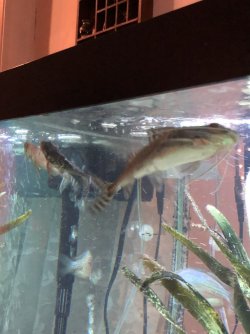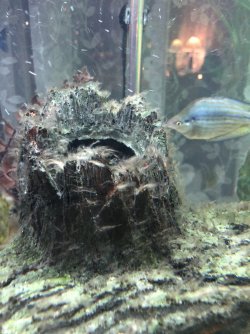Gracethom7
New Member
Hi all! Happy holidays. I’m home for the week where I am doing some routine maintenance on the fish tank at my parents house. It’s a 75 gallon freshwater tank that has been running for about 6 years. Normally, it’s pretty low maintenance, but in the last few weeks, I’ve had a few fish die, including two of the four pictus catfish that I’ve had since the tank was set up.
I bought a water testing kit, and it revealed really low ph and off the charts nitrates (no ammonia or nitrites). After a huge water change, the ph is back around 7.4 but the nitrates are still really high. I’m continuing with smaller water changes in an attempt to lower the nitrates.
My remaining catfish are acting strangely, swimming at the surface in one corner above the air stone, when they normally used to gather at the bottom of the tank. After doing some online research, I’m worried that the oxygen levels are low. Could this be related to the high nitrates? None of the other fish are displaying signs of low oxygen (they’re active, don’t crowd the surface, don’t appear to have labored breathing), but I read that the catfish would be the first to react.
The tank has an Aqueon HOB for 75-90 (carbon) and a fluvel canister filter for 75 (carbon, ammo chips, bio tablets)on opposite sides of the tank, and a water pump for circulation. There is one air stone. The temperature is about 80 degrees and it has a sand substrate. I use stress coat and aquarium salt (maybe about 1/2 teaspoon per gallon) during water changes. There are a couple of meager looking live plants that have been picked at/uprooted over the years by the fish. I ordered some frogbit that I’m hoping Will consume some nitrates, but it won’t arrive for another week.
Currently, the tank has 2 pictus catfish, 2 Australian rainbows, 2 turquoise rainbows, a large angel, a fairly large red blood parrot, and 0-2 clown plecos (I never see them, but the last time I replaced one I thought was dead, it reappeared). I typically keep more rainbows (between 4-6 of each) but they’ve also fallen victim over the last month or so, and I don’t want to replace them until I find out what’s going on.
Does it sound like the oxygen levels are an issue? Or is there something else at play here? Any suggestions for the nitrates? Many of the tank ornaments are covered in a fibrous plant or algae. I’m not sure if this is helping or hurting the oxygen/waste levels, but it’s really hard to remove. I’m really hoping to get this squared away before I head back, as my parents are not great for much more than feeding and algae scrubbing.
Thanks!
I bought a water testing kit, and it revealed really low ph and off the charts nitrates (no ammonia or nitrites). After a huge water change, the ph is back around 7.4 but the nitrates are still really high. I’m continuing with smaller water changes in an attempt to lower the nitrates.
My remaining catfish are acting strangely, swimming at the surface in one corner above the air stone, when they normally used to gather at the bottom of the tank. After doing some online research, I’m worried that the oxygen levels are low. Could this be related to the high nitrates? None of the other fish are displaying signs of low oxygen (they’re active, don’t crowd the surface, don’t appear to have labored breathing), but I read that the catfish would be the first to react.
The tank has an Aqueon HOB for 75-90 (carbon) and a fluvel canister filter for 75 (carbon, ammo chips, bio tablets)on opposite sides of the tank, and a water pump for circulation. There is one air stone. The temperature is about 80 degrees and it has a sand substrate. I use stress coat and aquarium salt (maybe about 1/2 teaspoon per gallon) during water changes. There are a couple of meager looking live plants that have been picked at/uprooted over the years by the fish. I ordered some frogbit that I’m hoping Will consume some nitrates, but it won’t arrive for another week.
Currently, the tank has 2 pictus catfish, 2 Australian rainbows, 2 turquoise rainbows, a large angel, a fairly large red blood parrot, and 0-2 clown plecos (I never see them, but the last time I replaced one I thought was dead, it reappeared). I typically keep more rainbows (between 4-6 of each) but they’ve also fallen victim over the last month or so, and I don’t want to replace them until I find out what’s going on.
Does it sound like the oxygen levels are an issue? Or is there something else at play here? Any suggestions for the nitrates? Many of the tank ornaments are covered in a fibrous plant or algae. I’m not sure if this is helping or hurting the oxygen/waste levels, but it’s really hard to remove. I’m really hoping to get this squared away before I head back, as my parents are not great for much more than feeding and algae scrubbing.
Thanks!


